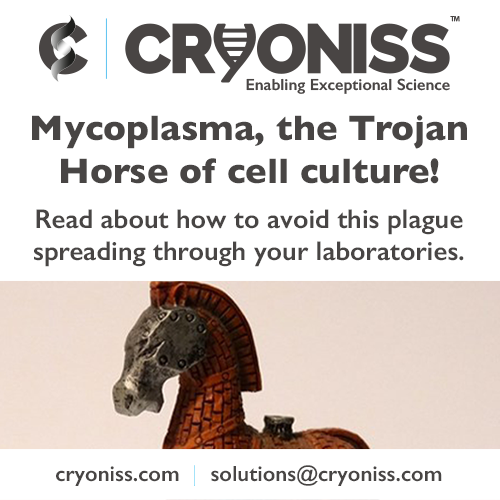Mycoplasma, the Trojan Horse of cell culture!

Mycoplasma are the smallest free-living organisms and considered to be the simplest form of bacteria, from the class Mollicutes.
The presence of Mycoplasma in cell culture has been well established, ever since researchers at John Hopkins identified these Mollicutes in the first immortalised cell line, HeLa in 1956. Since then, ~250 different strains of Mycoplasma have been discovered of which ~190 are known to infect cell cultures. Mycoplasma is considered a plague to a tissue culture laboratory.
Mollicutes are distinguished from other prokaryotic classes by a lack of a rigid cell wall, making antibiotic treatments somewhat challenging and the best response in the event of an outbreak is to bin everything and start again. Their tiny size (0.3 - 0.8 µM), and pleomorphic phenotype makes them indiscernible under a standard microscope, and impervious to 0.45 µM filtration systems routinely employed in laboratories. One Mycoplasma cell can grow to 106 colony forming units per ml within three to five days in an infected cell culture, and frequently there are between 100 to 1000 Mycoplasmas attached to each infected cell. However, there will be no visible signs to alert the researcher of the invasion. Unlike bacteria or fungi, Mycoplasma do not illicit changes in pH or turbidity of the culture media, nor changes to the host cell phenotype.
Mycoplasma have one of the smallest prokaryotic genomes, around 0.6 Mb, and therefore lack key genes required for the synthesis of macromolecular precursors and energy metabolism. To survive and replicate, they infect a host cell and like a parasite, compete for biosynthetic precursors and nutrients. They can alter DNA, RNA, and protein synthesis of the host cell by diminishing amino acid and ATP levels, introducing chromosomal alterations, and modifying host-cell plasma membrane antigens. Therefore, any downstream data generated from an infected culture will be compromised. The other concern is that Mycoplasma are highly infectious, and once present, if left to wreak havoc, can quickly spread throughout a laboratory particularly through dispersion of aerosol droplets, infecting other cell lines.
Where do these pesky bacteria come from?
The main source of Mycoplasma contamination continues to be the grateful receipt of infected cells from another lab, however contaminated cell culture medium reagents such as serum and trypsin; and laboratory personnel infected with for example M. orale or M. fermentans are other routes of infection.
Since 1956, there have been multiple papers estimating how widespread these infections are in the cell culture community, with reports ranging from 3% - 70%. However, in 2015, Anthony O. Olarerin-George and John B. Hogenesch, surveyed the NCBI’s RNA-seq archive to assess the prevalence of Mycoplasma. Analysing sequence data from 9395 rodent and primate samples form 884 series in the NCBI Sequence Read Archive, they found 11% were contaminated with Mycoplasma. However, what is more concerning, is that the contaminated series and associated data, have been published in top peer-reviewed journals such as Nature, Cell, PNAS, to name but a few. These articles have subsequently been cited, suggesting their importance to their respective fields. In particular, two contaminated series have over 500 citations.
How do you keep your laboratories clear of Mycoplasma?
To guarantee the quality of data being published, it is imperative that scientists maintain a Mycoplasma free lab, and the only way to do this is to use qualified starting cell lines, adhere to best practice tissue culture techniques and employ a routine Mycoplasma screening assay.
For support with implementing a Quality Control testing regime in your laboratories, contact qc.testing@cryoniss.com for more information.
























